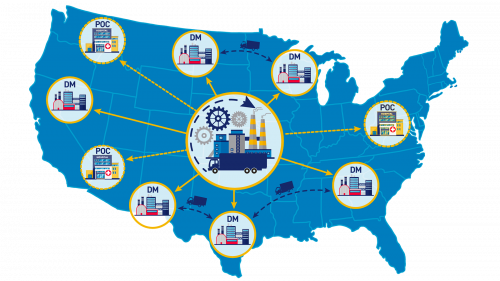FDA Seeks Feedback on Distributed and Point-of-Care Drug Manufacturing

By: Michael Kopcha, Ph.D., R.Ph., Director of the Office of Pharmaceutical Quality, Center for Drug Evaluation and Research, and Manuel Osorio, Ph.D., Senior Scientist, Immediate Office of the Director, Center for Biologics Evaluation and Research
Pharmaceutical manufacturers have generally produced drugs at large fixed-location facilities, but some are now developing smaller, mobile drug manufacturing processes that can be deployed to multiple locations, including at the point of care, such as at a hospital or clinic. These novel distributed manufacturing (DM) and point-of-care (POC) manufacturing technologies have the potential to improve the reliability and robustness of the drug supply chain. The U.S. Food and Drug Administration is keenly interested in these technologies because they could potentially provide flexibility for drug manufacturers to enable rapid and localized response to changing demand and increase timely access to quality drugs for U.S. patients.
For example, a health care facility could be interested in using a POC manufacturing technology to meet the specific needs of its patients, or DM units could be deployed at a location following a public health emergency to meet local demand for certain drugs.
Though there are currently no FDA-approved drugs being manufactured using DM or POC technology, the agency is proactively evaluating our existing risk-based regulatory framework as it applies to these technologies. The agency recognizes feedback from drug manufacturers and other stakeholders involved in the development of DM and POC technologies is critical to help inform the FDA’s evaluation of our existing regulatory framework.
Advanced Manufacturing and FDA’s Regulatory Framework
A March 2021 consensus report issued by the National Academies of Sciences, Engineering, and Medicine (NASEM) identified integrated, flexible, and distributed technologies as manufacturing innovations the agency can expect to soon see in regulatory submissions. These technologies included DM and POC technologies, as well as other related technologies such as end-to-end continuous manufacturing and the use of artificial intelligence.
The agency has already seen interest in the implementation of these technologies as several developers of DM and POC technologies have engaged with the FDA’s Center for Drug Evaluation and Research (CDER) Emerging Technology Program, and the Center for Biologics Evaluation and Research (CBER) Advanced Technologies team, which provide support and early engagement for stakeholders developing advanced manufacturing technologies.
CDER, with input from CBER, formed the Framework for Regulatory Advanced Manufacturing Evaluation (FRAME) initiative to proactively determine whether an application using an advanced manufacturing technology can fit within our existing regulatory framework with the intent of informing potential future policy development. The FRAME initiative is assessing existing guidance, regulations, and statutory authorities for areas of policy consideration including regulatory terminology, drug application requirements, and current regulations and standards. As part of FRAME, the FDA is conducting in-depth impact analyses to make initial recommendations for the FDA’s regulatory framework.
The agency is now increasing public outreach with stakeholders and soliciting public input to further inform our thinking as we begin implementing components of the regulatory framework.
FDA Seeks Public Feedback and Public Workshop in November
We recognize the FDA’s regulatory policies and programs may need to evolve to enable the timely adoption of DM and POC technologies. The agency has identified certain areas of consideration in a discussion paper and is asking for public feedback on some key questions identified in that paper:
- How often might a DM unit move to a new location and what might an applicant report to the agency when doing so?
- What locations are envisioned for POC unit operation?
- How might a centralized quality system (i.e., at a “parent location”) ensure each manufacturing unit complies with regulatory requirements and quality standards?
- What type of business relationships are envisioned between companies developing POC manufacturing platforms and health care facilities?
Interested stakeholders can provide input at a public workshop on Nov. 14-16 and to the public docket, under docket number FDA-2022-N-2316, listed in the Federal Register notice announcing the publication of the discussion paper. Additionally, manufacturers developing DM and POC technology can contact CDER’s Emerging Technology Program at [email protected] or CBER’s Advanced Technologies Team at [email protected] (add “CATT” to the subject line).
Feedback from drug manufacturers and stakeholders will help inform the FDA’s evaluation of our existing regulatory framework. We look forward to continuing our engagement with public stakeholders on the regulatory framework for advanced manufacturing technologies to ensure production of quality drugs for U.S. patients.


